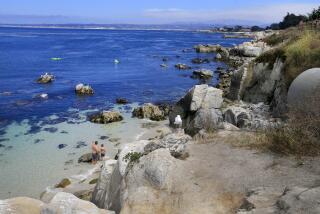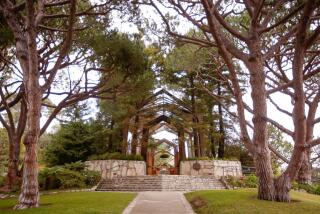Scientists explore 2,000 miles of the ocean floor -- and you can too
Now you can explore the ocean floor without leaving your desk.
The U.S. Geological Survey this week posted thousands of photos and videos of the U.S. coastline and adjacent seafloor, allowing users to explore sections of the Pacific, Atlantic and Gulf coasts in an interactive map. Most of the areas covered in the new imagery have never been seen before.
The new imagery covers nearly all of the California coast, creating a window to rocky reefs, sea critters, corals and more.
The database will give coastal managers and scientists a glimpse of the seafloor’s composition and the habitats present -- an important tool for habitat protection and understanding hazards, such as sea level rise and natural events, including earthquakes and tsunamis.
Scientists are “learning the dynamics of the seafloor and how things have changed in the last few decades,” said Nadine Golden, a USGS geographer based in Santa Cruz and principal investigator for the project. “Being able to get a picture of that is extremely useful.”
Making several expeditions a year, researchers in California dropped metal-encased cameras overboard and dragged them behind their boats. Two video cameras captured vertical and oblique angles, while a still camera shot one frame every 30 seconds. Because the boats were filming, they couldn’t move faster than a couple of knots, roughly 2.3 miles per hour. The Gulf and Atlantic imagery comes from a mix of boat and aerial surveys.
The result: about 100,000 photos and 1,000 hours of video footage covering almost 2,000 miles of coastline nationwide.
“Sometimes it’s not very exciting,” Golden said. “At times we go through rocky reefs, and we see sand and mud. We invite the public to do the same.”
Though it may seem dull, understanding how the patterns in undersea sand and mud form is becoming more important, especially as California beaches struggle with sand depletion and erosion, Golden said.
Already, Golden says, other researchers, resource managers and academics are using the portal in ways she hadn’t anticipated. For one, the University of California and a nonprofit biological research collaboration in the Monterey Bay National Marine Sanctuary are planning their next fieldwork project on a specific organism using USGS imagery. By using the data to find where the animal has been seen before, they can save time and money in reduced exploration costs.
And the public can enjoy the portal as well, whether it’s to take a virtual dive in their local waters or explore the depths of more distant shores.
“Be as creative as possible with it,” Golden said. “Imagine questions that weren’t possible to ask before.”
Find any sunken treasure? Let me know on Twitter @seangreene89.
“Like” Los Angeles Times Science & Health on Facebook.







